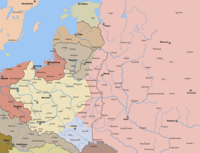Causes of the Polish–Soviet War
During the

In the winter of 1918–19 the recently established Russian Soviet Republic had already undertaken a "
For their part, the Poles aimed to secure their independence, contain any resurgence of the Russian or German Empires, and reclaim areas in the east that had ethnic Polish populations as per the historical Polish–Lithuanian Commonwealth borders that existed prior to the Partitions of Poland. An ambitious plan formulated by Polish head of state Józef Piłsudski aimed to create a wide "Intermarium" (Międzymorze) federation of independent states to the west of Russia, of which Poland would be the leading member. Limiting Russian control of Ukraine was essential to this plan, and Poland was already at war with Ukrainian forces over Eastern Galicia.

As 1919 progressed, Soviet forces conquered
The prehistory
The territory, where this conflict broke out, was a part of the medieval
The combination of social, language, religious and cultural oppressions had led to destructive
The situation
In the
Germany, however, had not been keen to see Russia grow strong again and—exploiting her control of those territories, had quickly granted limited independence as buffer states to Finland, Estonia, Latvia, Lithuania, Poland, Belarus and Ukraine. As Germany's defeat rendered her plans for the creation of those Mitteleuropa puppet states obsolete, and as Russia sank into the depths of the Russian Civil War, the newly emergent countries saw a chance for real independence and were not prepared to easily relinquish this rare gift of fate. At the same time, Russia saw these territories as rebellious Russian provinces but was unable to react swiftly, as it was weakened and in the process of transforming herself into the Soviet Union through the Russian Revolution and Russian Civil War that had begun in 1917.
With the success of the

Poland was not alone in its newfound opportunities and troubles. Most if not all of the newly independent neighbours began fighting over borders:
Spreading communist influences resulted in communist revolutions in Munich, Berlin, Budapest and Prešov. Winston Churchill commented: "The war of giants has ended, the wars of the pygmies begin."[4] All of those engagements – with the sole exception of the Polish-Soviet war – would be short-lived border conflicts.
The Polish–Soviet war likely happened more by accident than design, as it is unlikely that anyone in Soviet Russia or in the new Second Republic of Poland would have deliberately planned a major foreign war.[5][6]
Poland, its territory a major frontline of the First World War, was unstable politically; it had just won the difficult conflict with the West Ukrainian National Republic and was already engaged in new conflicts with Germany (the
The situation in Russia was similar. The attention of revolutionary Russia, meanwhile, was predominantly directed at thwarting counter-revolution and
Piłsudski's motives

Polish politics were under the strong influence of statesman and Marshal
Poland had never any intention of joining the Western intervention in the Russian Civil War or conquering Russia, as it has done once in the 17th century during the
Lenin's motives

In April 1920, when the Red Army's major push towards Polish hinterlands took place, the soldiers and commanders were told that defeat of Poland was not only necessary but simply sufficient for the "oppressed masses of the proletariat" to rise worldwide and create a "workers' paradise." In the words of General Tukhachevski: "To the West! Over the corpse of White Poland lies the road to world-wide conflagration. March on Vilno, Minsk, Warsaw!".[7]
In late 1919 the leader of Russia's new
Germany in 1918-1920 was a nation torn by social discontent and embroiled in political chaos. Since the
In April 1920 Lenin would complete writing The Infantile Disease of "Leftism" in Communism, a guide to the final stages of the Revolution. He became overconfident, entertaining the thoughts of a serious war with Poland. According to him and his adherents, the Revolution in Russia was doomed unless it was to become worldwide. The debate in Russia was "not as to whether the Polish bridge should be crossed, but how and when." According to Lenin's doctrine of "revolution from outside" Red Army's advance into Poland would be an opportunity "to probe Europe with the
References
- ISBN 5-17-002142-9
- ISBN 0-7126-0694-7. (First edition: New York, St. Martin's Press, inc., 1972.) Page 21.
- ^ ISBN 0-7126-0694-7. (First edition: New York, St. Martin's Press, inc., 1972.) Page 22
- ^ Mikhail Tukhachevski, order of the day, July 2, 1920.
- ^ Lincoln, Red Victory: a History of the Russian Civil War.
See



